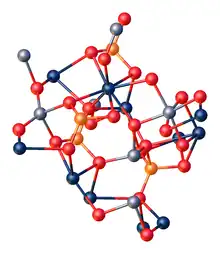Lanthanum gallium silicate
Lanthanum gallium silicate (referred to as LGS in this article), also known as langasite, has a chemical formula of the form A3BC3D2O14, where A, B, C and D indicate particular cation sites. A is a decahedral (Thomson cube) site coordinated by 8 oxygen atoms. B is octahedral site coordinated by 6 oxygen atoms, and C and D are tetrahedral sites coordinated by 4 oxygen atoms. In this material, lanthanum occupied the A-sites, gallium the B, C and half of D-sites, and, silicon the other half of D-sites.[1]
 | |
| Names | |
|---|---|
| Other names
LGS or langasite | |
| Identifiers | |
3D model (JSmol) |
|
| |
| |
| Properties | |
| Ga5La3O14Si | |
| Molar mass | 1017.402 g·mol−1 |
| Appearance | colorless solid |
| Density | 5.75 g/cm3 |
| Melting point | 1,470 °C (2,680 °F; 1,740 K) |
| insoluble | |
Except where otherwise noted, data are given for materials in their standard state (at 25 °C [77 °F], 100 kPa).
Infobox references | |
LGS is a piezoelectric material,[2] with no phase transitions up to its melting point of 1470 °C. Single crystal LGS can be grown via the Czochralski method, in which crystallization is initiated on a rotating seed crystal lowered into the melt followed by pulling from the melt.[3] The growth atmosphere is usually argon or nitrogen with up to 5% of oxygen. The use of oxygen in the growth environment is reported to suppress gallium loss from the melt; however, too high an oxygen level can lead to platinum (crucible material used for the melt) dissolution in the melt. The growth of LGS is primarily along the z direction. Currently the 3-inch (76 mm) langasite boules produced commercially have growth rates of 1.5 to 5 mm/h. The quality of the crystals tends to improve as the growth rate is reduced.
See also
References
- Belokoneva, E.L.; Stefanovich, S.Yu.; Pisarevskii, Yu.V.; Mosunov, A.V. "Refined structures of La3Ga5SiO14 and Pb3Ga2Ge4O14 and the Crystal Chemical Regularities in the Structure and Properties of Compounds of the Langasite Family (translated title), Zhurnal Neorganicheskoi Khimii (2000) 45, (11), 1786-p1796.
- Polishing and Etching Langasite and Quartz, Laffey SH and Vig JR, 1994 IEEE International Frequency Control Symposium doi:10.1109/FREQ.1994.398330
- Bohm, J.; Heimann, R.B.; Hengst, M.; Roewer, R.; Schindler, J. (1999). "Czochralski growth and characterization of piezoelectric single crystals with langasite structure: La3Ga5SiO14 (LGS), La3Ga5.5Nb0.5O14 (LGN), and La3Ga5.5Ta0.5O14 (LGT)". Journal of Crystal Growth. 204 (1–2): 128–136. doi:10.1016/S0022-0248(99)00186-4.